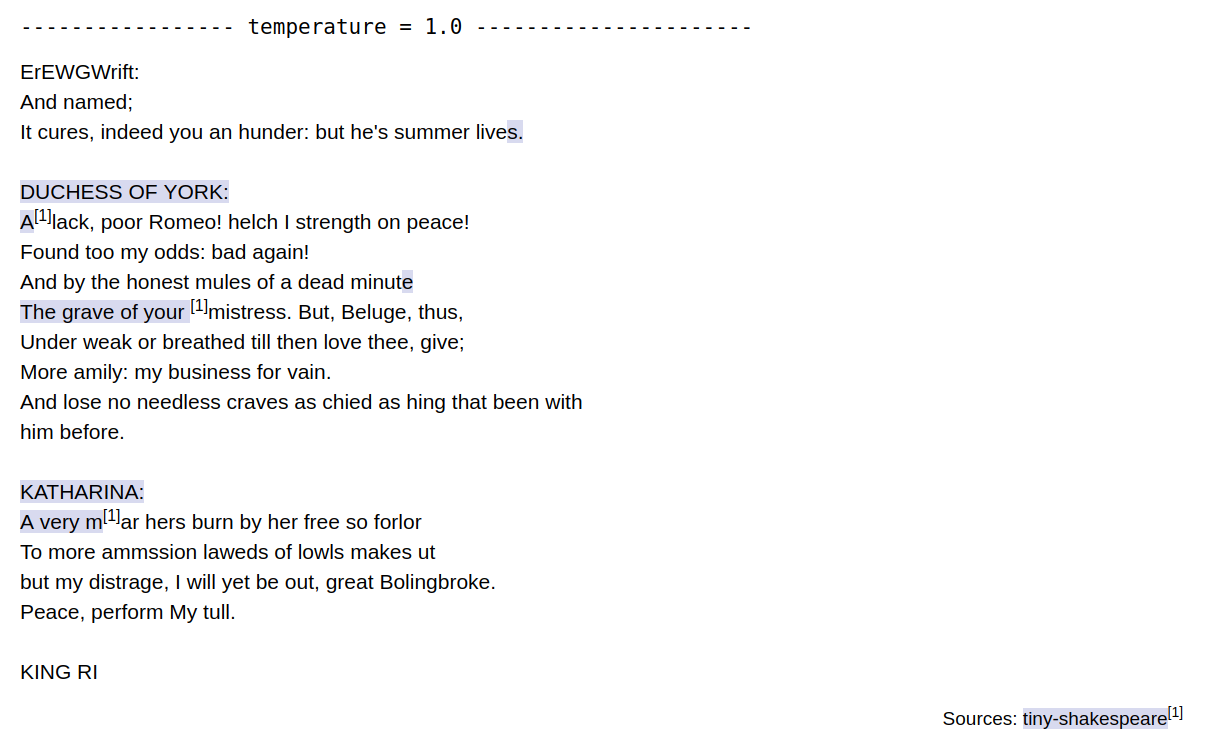This project is now archived, due to the relentless API-changing-activities on tensorflow...
These are tensorflow implemention along the ideas of Andrej Karpathy's char-rnn as described in 'The Unreasonable Effectiveness of Recurrent Neural Networks'.
These Jupyter notebooks for Tensorflow 2.x trains multi-layer LSTMs on a library of texts and then generate new text from the neural model. Through color-highlighting, source-references within the text generated by the model are used to link to the original sources. This visualizes how similar the generated and original texts are.
Run TF 2.x tensor_poet notebook in Google Colab on GPU, on TPU.
See also a newer version using transformers: transformer-poet
- Runs as local notebook on CPU, GPU or (with tensorflow_plugin on Apple hardware.
tensor_poetuses the Tensorflow 2 API- Generates samples periodically, including source-markup.
- Saves model training data periodically, allows restarts.
- Tensorboard support
- Support for dialog with the generative model
Note: This is not scientific benchmark data, just a single snapshot of tests with 4-layer LSTMs, about 7.5M parameters.
| Platform | time per iteration | relative performance |
|---|---|---|
| NVidia 1080ti | 155ms | 7x |
| Google Colab Tesla T4 | 241ms | 4.5x |
| Mac mini M1 | 453ms | 2.4x |
M1 arm64 notes: requires at least Apple's tensorflow_macos >=2.8 and tensorflow_metal >= 0.4. Version earlier had a broken LSTM implementation.
- 2022-03-06: Retested with Tensorflow 2.8 and latest Apple plugins. Apple's LSTM seems fixed now! (tensorflow_macos 2.8, tensorflow_metal 0.4). Now TPU in Colab is broken for LSTMs (bad convergence).
- 2021-10-13: Retested with Tensorflow 2.6 and latest Apple plugins. While tensorflow_metal is fast, the current LSTM implementation seems broken, training does not converge to meaningful results with Apple's HW/SW.
- 2021-08-21: Fixed links to Gutenberg, retests with Apple's latest plugins.
- 2021-06-10: Removed Tensorflow v1 code.
- 2021-06-09: Removed ml-compute specific code, apple M1 now usess tensorflow 2.5 pluggable device interface, which doesn't require custom code. Works only with TF 2.5 and higher, Apple's Tensorflow Plugin needs to be installed for Apple platforms.
- 2020-12-11: Apple M1 neural engine working with tensorflow_macos 0.1-alpha1
- 2020-12-09: Fix broken text data URL (Gutenberg), renamed old v1
tensor_poettotensor_poet_old_tf_v1, andeager_poettotensor_poet, since eager-mode isn't useful for TPUs and MLCompute. - 2020-11-25: TF 2.3 fixes (api change) for TPU training. First experiments with tensorflow_macos arm64/x86_64 :(apple_poet.py, not functional).
- 2020-03-18: TPU training on colab now works.
- 2020-02-11: TF 2.1 colab now does things with TPU. The secret was to move the embeddings layer to cpu. Unfortunately, the result is just super-slow.
- 2019-11-20: TF 2.0 gpu nightly: No visible TPU in colab support progresses so far. keras.fit() still crashes, currently Tensorboard broken with nightly too. TF 1 version: Make sure, tf 1.x is selected in colab.
- 2019-08-26: TPU/colab now at least initializes the TPU hardware, but Keras fit() still crashes.
- 2019-06-15: TPU tests with Tensorflow 2 beta, allocation of TPUs works, training errors out with recursion error.
- 2019-05-16: First (unfinished) test version for Tensorflow 2 alpha.
- 2019-05-16: Last tensorflow 1.x version, testet with 1.13.
- 2018-10-01: Adapted for tensorflow 1.11, support for Google Colab.
- 2018-05-13: Retested with tensorflow 1.8.
- 2018-03-02: Adapted for tensorflow 1.6, upcoming change to tf.nn.softmax_cross_entropy_with_logits_v2
- 2017-07-31: tested against tensorflow 1.3rc1: worked ok, for the first time the tf api did not change.
- 2017-05-19: adapted for tensorflow 1.2rc0: batch_size can't be given as tensor and used as scalar in tf-apis.
- 2017-04-12: adapted for tensorflow 1.1 changes: definition of multi-layer LSTMs changed
A sample model (8 layers of LSTMs with 256 neurons) was trained for 20h on four texts from Project Gutenberg: Pride and Prejudice_ by Jane Austen, Wuthering Heights by Emily Brontë, The Voyage Out by Virginia Woolf and Emma_by Jane Austen
Intermediate results after 20h of training on an NVIDIA GTX 980 Ti:
Epoch: 462.50, iter: 225000, cross-entropy: 0.378, accuracy: 0.88851The highlighters show passages of minimum 20 characters that are verbatim copies from one of the source texts.
- Based on the efficient implementation of LSTMs in Tensorflow 2.x
- A single model is used for training and text-generation, since dynamic_rnns became flexible enough for this
- Tensorflow 2.x has nice performance improvements for deeply nested LSTMs both on CPU and GPU (the code runs completely on GPU, if on is available). Even a laptop without GPU starts generating discernable text within a few minutes.
- Deeply nested LSTMs (e.g. 10 layers) are supported.
- Multiple source-text-files can be given for training. After text generation, color-highlighting is used to show, where the generated text is equal to some text within the source. Thus one can visualize, how free or how close the generated text follows the original training material.
- Support for different temperatures during text generation
- Tensorboard support
- Tensorflow
- Python 3
- Jupyter Notebook
Then, the model generates samples, and highlighting references to the original training text:
This improves over time.
To generate higher quality text, use the param dict:
params = {
"vocab_size": len(textlib.i2c),
"neurons": 128,
"layers": 2,
"learning_rate": 1.e-3,
"steps": 64,}Increasing neurons to 512, layers to 5 and steps to 100 will yield significant higher quality output.
You can add multiple text sources, by including additional file references in:
textlib = TextLibrary([ # add additional texts, to train concurrently on multiple srcs:
'data/tiny-shakespeare.txt',
])Upon text generation, the original passages from the different sources are marked with different highlighting.
If your generated text becomes a single highlighted quote, then your network is overfitting (or plagiarizing the original). In our cause, plagiarizing can be addressed by reducing the net's capacity (fewer neurons), or by adding more text.
- Andrej Karpathy's char-rnn
- The Unreasonable Effectiveness of Recurrent Neural Networks
- See torch-poet for a similar implementation using PyTorch.
- See rnnreader for a pure C++ implementation (no Tensorflow) of the same idea.
- Newer version using transformers: transformer-poet
- Helper libraries for Gutenberg-access and ML-hardware abstraction: ml_indie_tools



